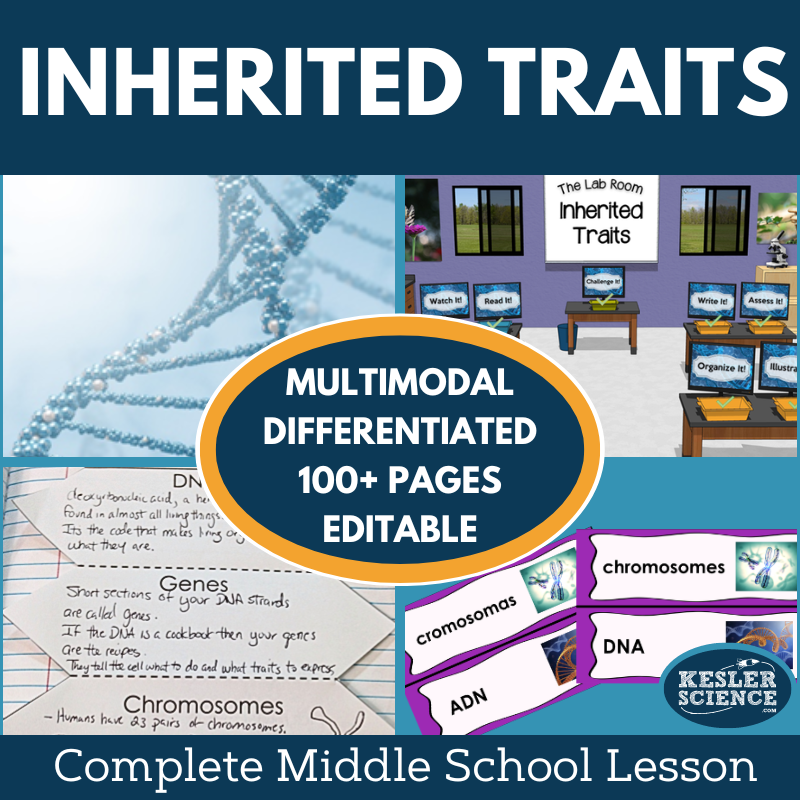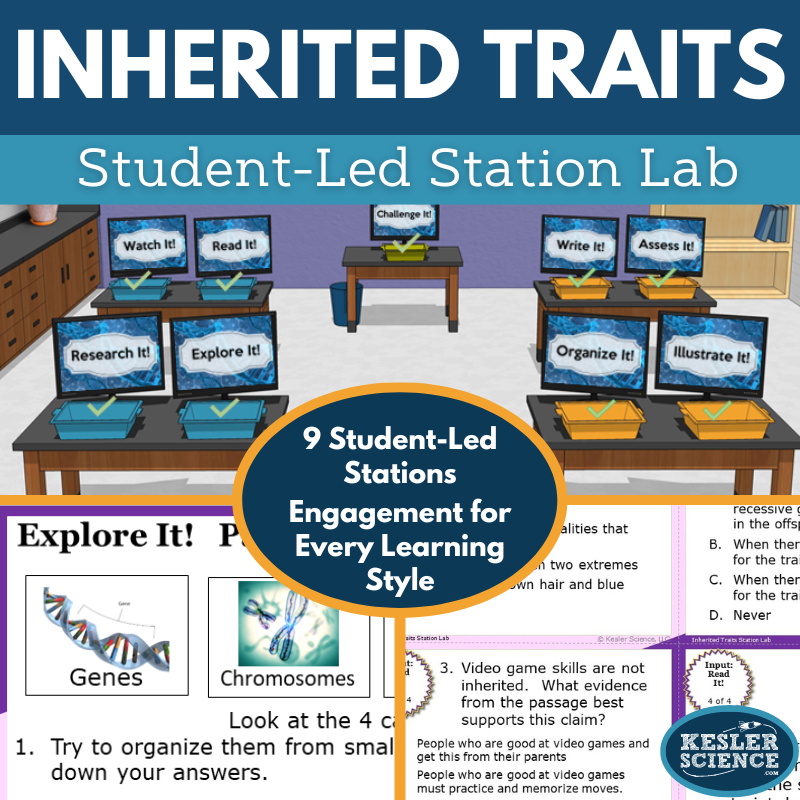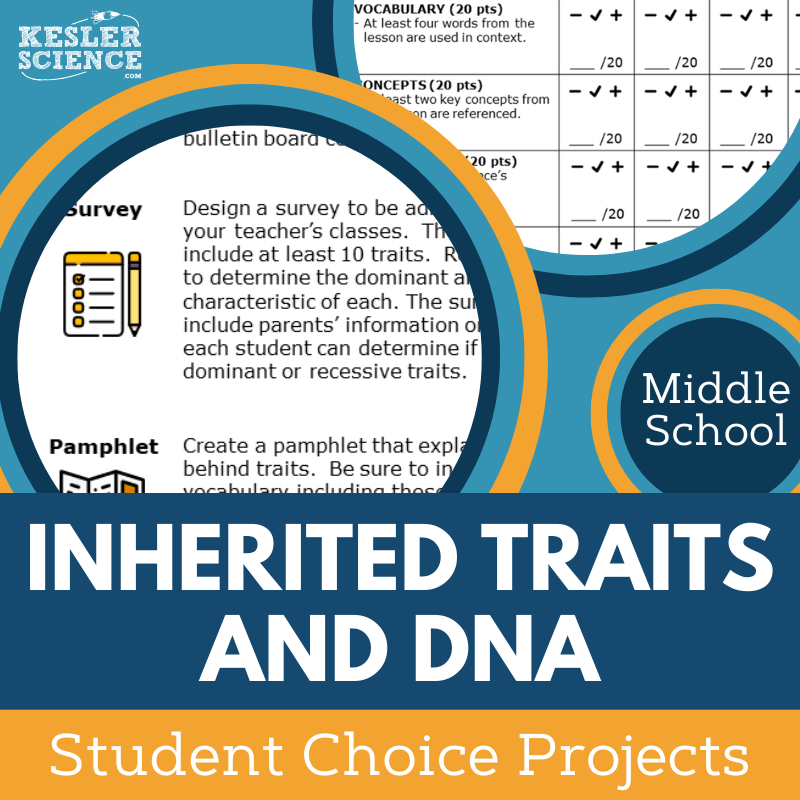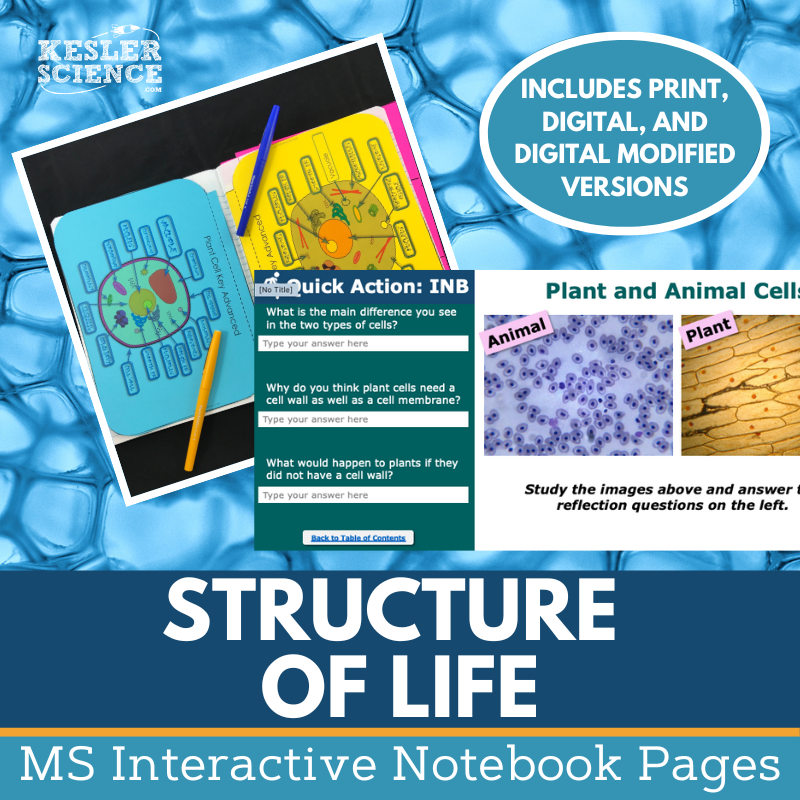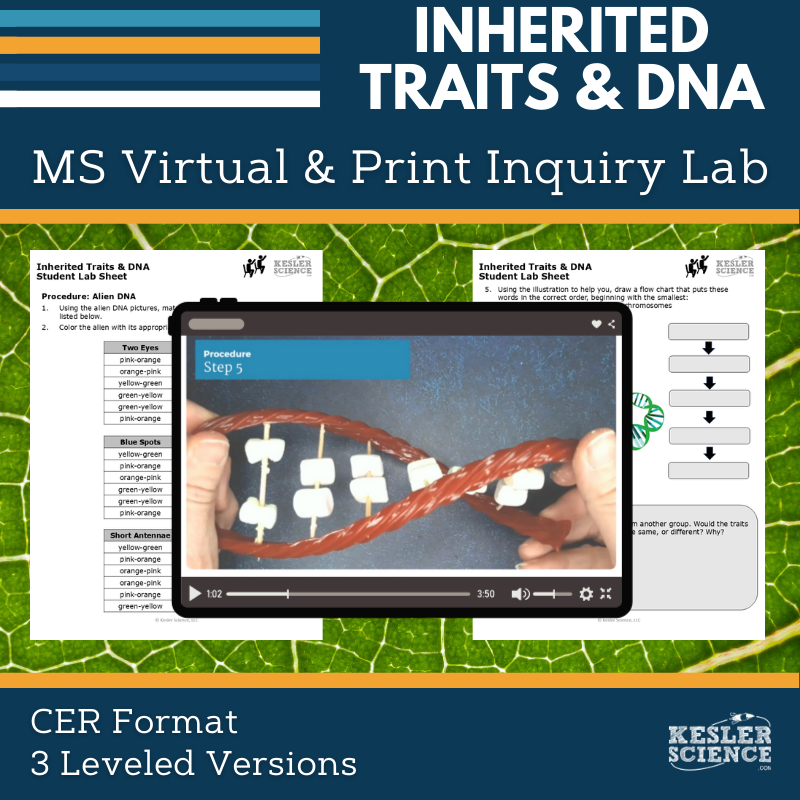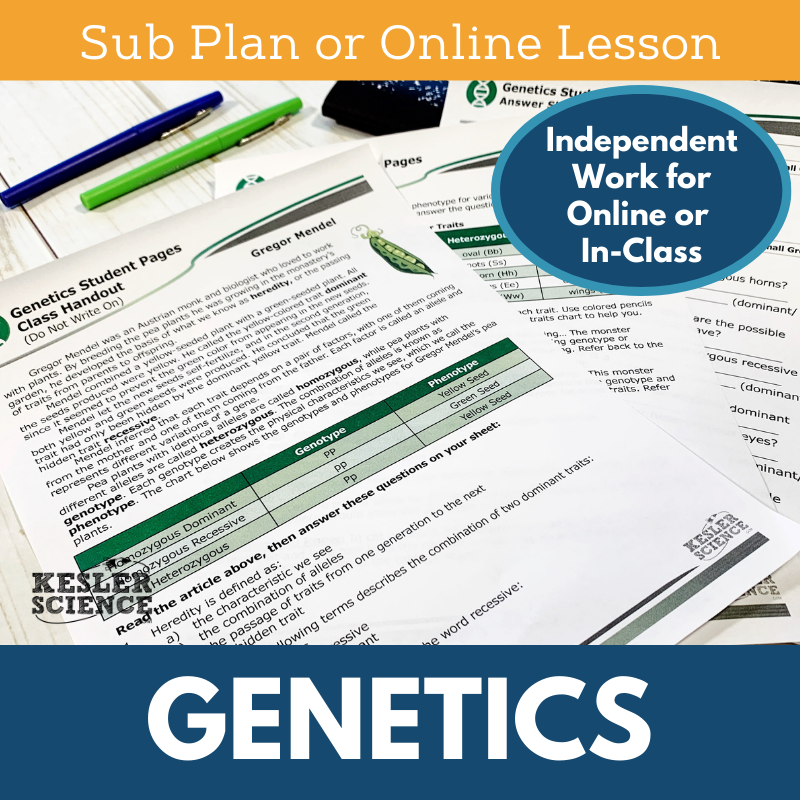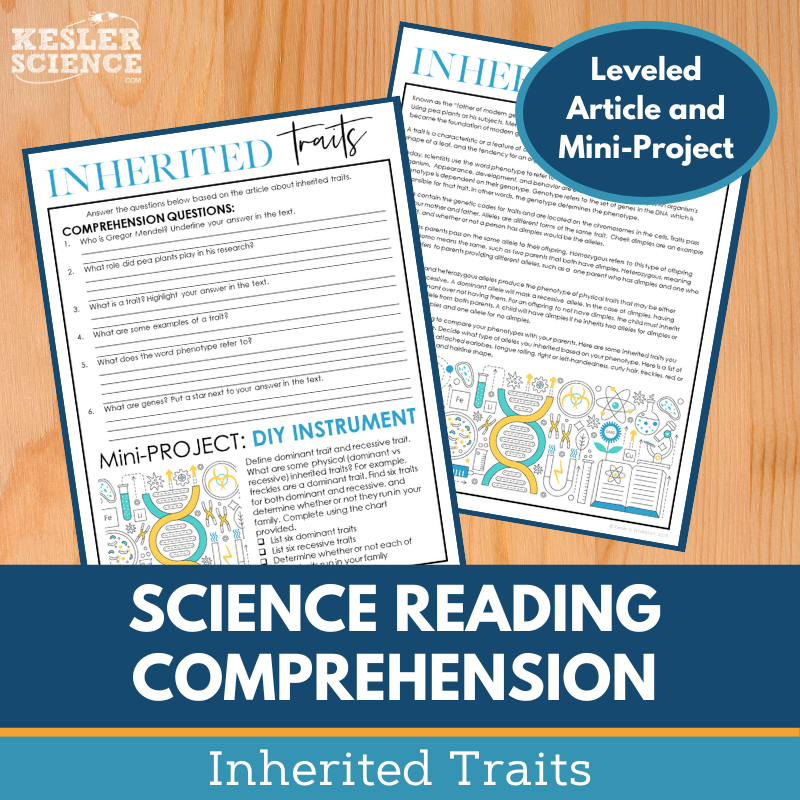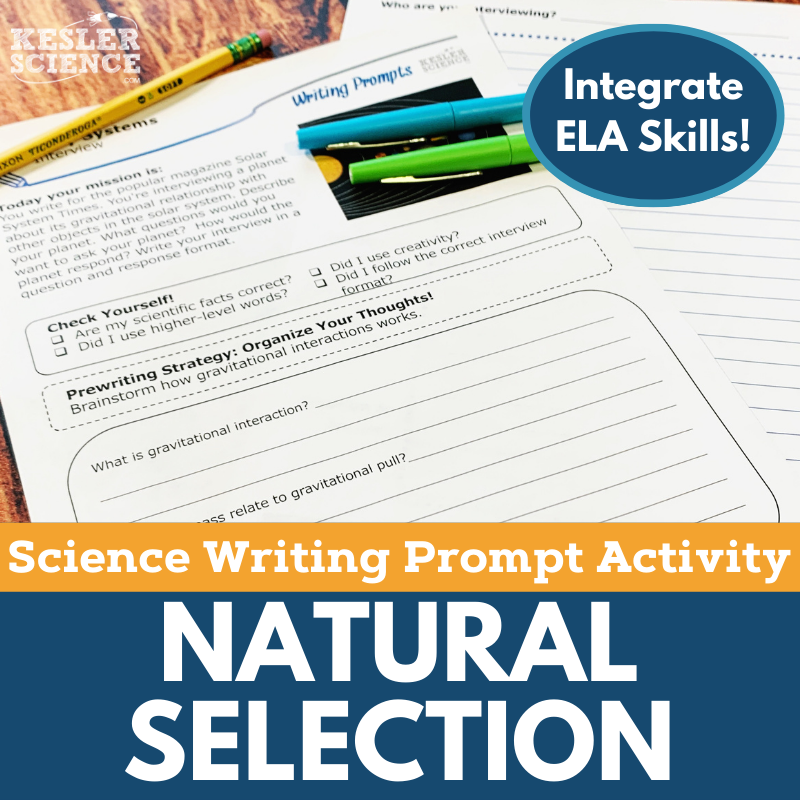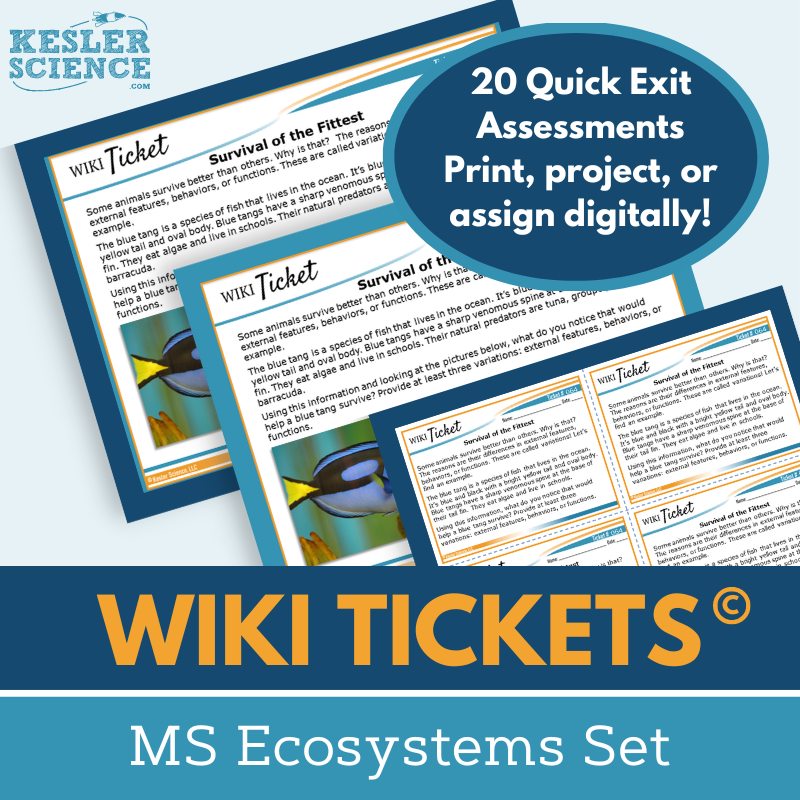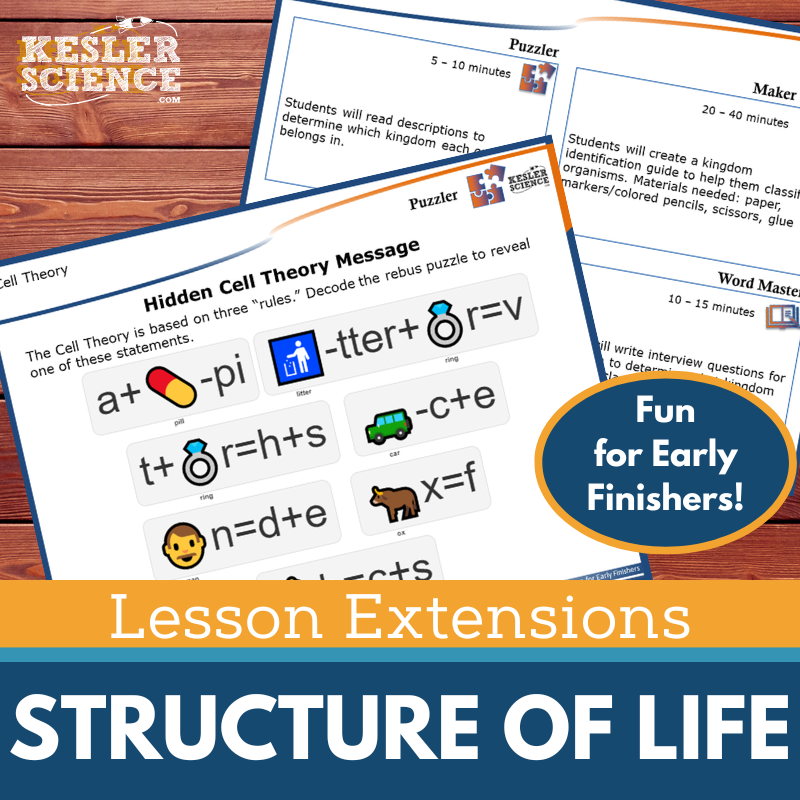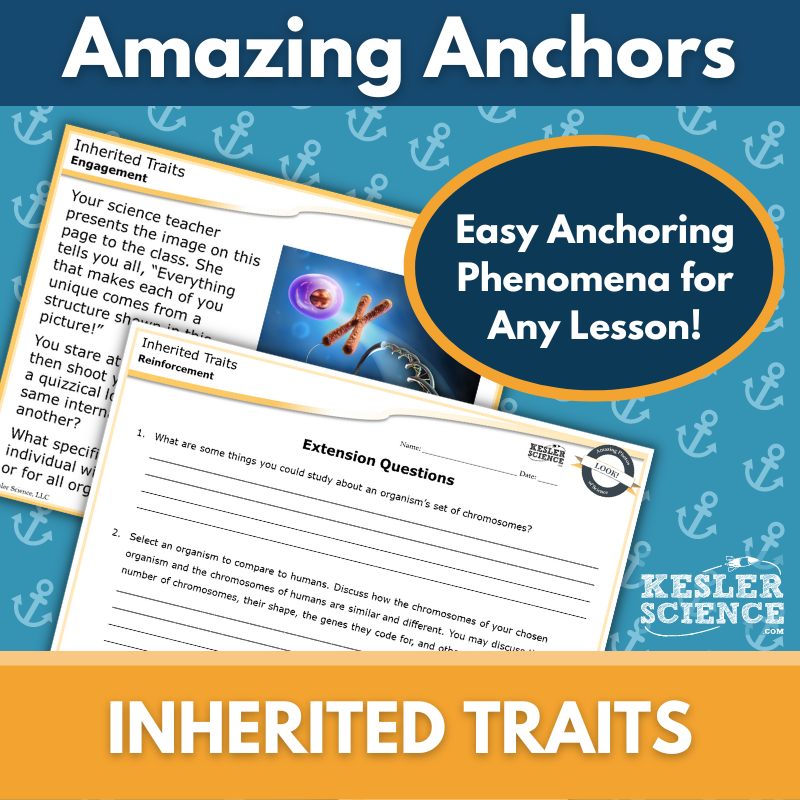Inherited Traits and DNA Activities for Middle School Science
The Kesler Science Inherited Traits resources provide a comprehensive, student-centered approach to learning about genetics and inheritance. Whether for class activities, projects, or assessments, these materials offer everything needed to effectively teach and reinforce the concepts of inherited traits and DNA. All of the following materials are also included in the Kesler Science Membership.
The Kesler Science Inherited Traits Complete 5E Lesson provides everything needed to teach a comprehensive, multi-day lesson for 6th–8th grade students. This student-led, easy-to-implement resource allows teachers to focus on student success while offering differentiated materials to support various learning needs. It includes editable PowerPoints, Spanish translations, and both printable and digital formats to fit your classroom or virtual learning environment.
Following the 5E Model (Engagement, Exploration, Explanation, Elaboration, Evaluation), the lesson engages students with interactive activities like objectives and word wall cards. In the Exploration phase, students work through nine differentiated stations that cover both input (e.g., “Explore It!” hands-on demos and “Read It!” comprehension passages) and output stations (e.g., “Organize It!” hands-on tasks and “Assess It!” quizzes). These stations cater to a variety of learning styles, with opportunities for students to apply their knowledge in creative ways.
The lesson concludes with opportunities for students to further elaborate on their learning through student-choice projects. Evaluation is built in through formal assessments and review questions, with adaptable options to support a range of learners. This flexible and engaging resource is perfect for in-person or remote classrooms, making it an excellent choice for any teaching environment.
The Kesler Science Inherited Traits Complete 5E Lesson provides everything needed to teach a comprehensive, multi-day lesson for 6th–8th grade students. This student-led, easy-to-implement resource allows teachers to focus on student success while offering differentiated materials to support various learning needs. It includes editable PowerPoints, Spanish translations, and both printable and digital formats to fit your classroom or virtual learning environment.
Following the 5E Model (Engagement, Exploration, Explanation, Elaboration, Evaluation), the lesson engages students with interactive activities like objectives and word wall cards. In the Exploration phase, students work through nine differentiated stations that cover both input (e.g., “Explore It!” hands-on demos and “Read It!” comprehension passages) and output stations (e.g., “Organize It!” hands-on tasks and “Assess It!” quizzes). These stations cater to a variety of learning styles, with opportunities for students to apply their knowledge in creative ways.
The lesson concludes with opportunities for students to further elaborate on their learning through student-choice projects. Evaluation is built in through formal assessments and review questions, with adaptable options to support a range of learners. This flexible and engaging resource is perfect for in-person or remote classrooms, making it an excellent choice for any teaching environment.
The Kesler Science Inherited Traits Station Lab is a modular, student-led activity that engages middle school students while they explore and compare inherited traits. With nine differentiated stations, this resource allows students to direct their own learning, fostering independence while the teacher facilitates. The lab is designed to save prep time while ensuring a comprehensive, interactive learning experience.
The nine stations include both input and output activities that address various learning styles. Input stations such as “Explore It!” and “Read It!” introduce new concepts through hands-on demonstrations, readings, and digital activities. Output stations like “Illustrate It!” and “Assess It!” give students the opportunity to express their understanding through visual models, writing prompts, and assessments.
This station lab is fully adaptable for both in-person and virtual learning. The digital version allows students to complete tasks using platforms like PowerPoint or Google Slides, making it perfect for remote or hybrid classrooms. Whether in the classroom or online, students can engage in meaningful learning through this student-centered approach to genetics.
The Kesler Science Inherited Traits Station Lab is a modular, student-led activity that engages middle school students while they explore and compare inherited traits. With nine differentiated stations, this resource allows students to direct their own learning, fostering independence while the teacher facilitates. The lab is designed to save prep time while ensuring a comprehensive, interactive learning experience.
The nine stations include both input and output activities that address various learning styles. Input stations such as “Explore It!” and “Read It!” introduce new concepts through hands-on demonstrations, readings, and digital activities. Output stations like “Illustrate It!” and “Assess It!” give students the opportunity to express their understanding through visual models, writing prompts, and assessments.
This station lab is fully adaptable for both in-person and virtual learning. The digital version allows students to complete tasks using platforms like PowerPoint or Google Slides, making it perfect for remote or hybrid classrooms. Whether in the classroom or online, students can engage in meaningful learning through this student-centered approach to genetics.
The Kesler Science Inherited Traits Student Choice Projects lesson empowers middle school students to select a project that suits their learning style. With six project options and a “design your own” choice, students can demonstrate their understanding of inherited traits creatively. A grading rubric allows for flexible assessments, which can be adjusted by teachers, peers, or students themselves.
This dynamic, student-centered resource offers nine project options, including differentiated versions to meet diverse learning needs. For students needing extra support, three project options are tailored for remediation, while more advanced students can combine multiple projects for added challenge. The editable rubric ensures projects can be customized to fit various grading preferences.
With minimal supplies like paper, markers, and scissors, many projects can be completed digitally, making them adaptable to different classroom settings. Teacher directions, a project choice board, and a rubric are provided to guide the process, ensuring flexibility and ease of use for teachers and students alike.
The Kesler Science Inherited Traits Student Choice Projects lesson empowers middle school students to select a project that suits their learning style. With six project options and a “design your own” choice, students can demonstrate their understanding of inherited traits creatively. A grading rubric allows for flexible assessments, which can be adjusted by teachers, peers, or students themselves.
This dynamic, student-centered resource offers nine project options, including differentiated versions to meet diverse learning needs. For students needing extra support, three project options are tailored for remediation, while more advanced students can combine multiple projects for added challenge. The editable rubric ensures projects can be customized to fit various grading preferences.
With minimal supplies like paper, markers, and scissors, many projects can be completed digitally, making them adaptable to different classroom settings. Teacher directions, a project choice board, and a rubric are provided to guide the process, ensuring flexibility and ease of use for teachers and students alike.
The Kesler Science Structure of Life Interactive Notebook Bundle provides an engaging way for students to explore life science concepts through interactive activities. Designed for both print and digital use, this resource is perfect for traditional classrooms, 1:1 environments, and distance learning. Topics covered include cell theory, genetics, plant and animal cells, and more, offering a comprehensive tool for teaching the structure of life.
The digital version includes a unique interactive notebook PowerPoint that can be uploaded to platforms like Google Slides or MS Teams, complete with reflection pages, note spaces, and an answer key. A modified digital version is also provided for students needing accommodations. The paper version features blank and pre-filled templates, along with color photos to guide usage, ensuring all students can participate effectively.
With resources tailored for diverse learning needs, the Kesler Science Structure of Life Interactive Notebook Bundle supports differentiated instruction and student-centered learning. Teachers gain a versatile tool for enhancing understanding, while students build lasting connections to key life science concepts.
The Kesler Science Structure of Life Interactive Notebook Bundle provides an engaging way for students to explore life science concepts through interactive activities. Designed for both print and digital use, this resource is perfect for traditional classrooms, 1:1 environments, and distance learning. Topics covered include cell theory, genetics, plant and animal cells, and more, offering a comprehensive tool for teaching the structure of life.
The digital version includes a unique interactive notebook PowerPoint that can be uploaded to platforms like Google Slides or MS Teams, complete with reflection pages, note spaces, and an answer key. A modified digital version is also provided for students needing accommodations. The paper version features blank and pre-filled templates, along with color photos to guide usage, ensuring all students can participate effectively.
With resources tailored for diverse learning needs, the Kesler Science Structure of Life Interactive Notebook Bundle supports differentiated instruction and student-centered learning. Teachers gain a versatile tool for enhancing understanding, while students build lasting connections to key life science concepts.
The Kesler Science Inherited Traits and DNA Inquiry Lab allows students to explore how traits are determined by DNA through hands-on or digital activities. Students will model a DNA strand representing one gene and create a flowchart to visualize the relationship between a gene, DNA, chromosome, nucleus, and cell. Both print and digital versions include comprehension questions, C.E.R. prompts, and a reflection section to support deeper understanding.
The lab is differentiated at three levels to meet the needs of diverse learners. The Dependent version offers guided inquiry with procedural steps, the Modified version provides structured support with simplified tasks and sentence stems, and the Independent version challenges students with a more self-directed experience. This flexible format ensures all students can engage meaningfully with the content.
Print labs use materials like red rope candy, colored mini-marshmallows, and toothpicks to build physical DNA models. The digital version requires no supplies and includes interactive elements compatible with Google Slides and other platforms. Editable teacher resources, answer keys, and support materials are provided for ease of implementation and customization.
The Kesler Science Inherited Traits and DNA Inquiry Lab allows students to explore how traits are determined by DNA through hands-on or digital activities. Students will model a DNA strand representing one gene and create a flowchart to visualize the relationship between a gene, DNA, chromosome, nucleus, and cell. Both print and digital versions include comprehension questions, C.E.R. prompts, and a reflection section to support deeper understanding.
The lab is differentiated at three levels to meet the needs of diverse learners. The Dependent version offers guided inquiry with procedural steps, the Modified version provides structured support with simplified tasks and sentence stems, and the Independent version challenges students with a more self-directed experience. This flexible format ensures all students can engage meaningfully with the content.
Print labs use materials like red rope candy, colored mini-marshmallows, and toothpicks to build physical DNA models. The digital version requires no supplies and includes interactive elements compatible with Google Slides and other platforms. Editable teacher resources, answer keys, and support materials are provided for ease of implementation and customization.
The Kesler Science Genetics Sub Plans guide students through a warm-up puzzle, reading passage, and independent activity, all while exploring DNA and genetic traits. Students analyze a table to understand homozygous dominant, heterozygous, and homozygous recessive traits and complete related questions. Early finishers can extend their learning by creating and illustrating "monster parents" and describing their genotypes and phenotypes.
The lesson includes detailed instructions for substitutes and is designed to keep students engaged, with activities, behavior checkpoints, and assessments. The comprehensive genetics lesson comes with a variety of handouts and assessments to accommodate multiple sections and class sizes. There are also options for distance learning with Google Form answer sheets and PDFs for online annotation.
These sub plans are flexible and easy to implement, whether in-person, remote, or for extended assignments. Teachers can use them for sub days, homework, extra credit, or small group instruction. The materials are student-centered, with clear directions and editable formats to suit different teaching needs.
The Kesler Science Genetics Sub Plans guide students through a warm-up puzzle, reading passage, and independent activity, all while exploring DNA and genetic traits. Students analyze a table to understand homozygous dominant, heterozygous, and homozygous recessive traits and complete related questions. Early finishers can extend their learning by creating and illustrating "monster parents" and describing their genotypes and phenotypes.
The lesson includes detailed instructions for substitutes and is designed to keep students engaged, with activities, behavior checkpoints, and assessments. The comprehensive genetics lesson comes with a variety of handouts and assessments to accommodate multiple sections and class sizes. There are also options for distance learning with Google Form answer sheets and PDFs for online annotation.
These sub plans are flexible and easy to implement, whether in-person, remote, or for extended assignments. Teachers can use them for sub days, homework, extra credit, or small group instruction. The materials are student-centered, with clear directions and editable formats to suit different teaching needs.
The Kesler Science Inherited Traits Reading Comprehension activity engages middle school students in learning about phenotypes, genotypes, and DNA through an informative nonfiction article. Students deepen their understanding by answering comprehension questions and completing a mini-project, where they create an imaginary family tree to trace traits over three generations.
Designed for grades 6-8, this leveled science passage supports both reading comprehension and science literacy. The resource includes 5-7 comprehension questions, a hands-on mini-project, and a Cornell notes template for students. With colorful graphics and options for students to annotate the text, this activity encourages critical thinking and enhances engagement.
The resource is ideal for a variety of classroom settings, including distance learning, where it can be used in Google Classroom or other platforms. With flexible materials, including online student answer sheets and editable PDFs, the lesson is perfect for absent students, extra credit, and as part of science sub plans. This activity helps build textual analysis and comprehension skills while fostering classroom discussions.
The Kesler Science Inherited Traits Reading Comprehension activity engages middle school students in learning about phenotypes, genotypes, and DNA through an informative nonfiction article. Students deepen their understanding by answering comprehension questions and completing a mini-project, where they create an imaginary family tree to trace traits over three generations.
Designed for grades 6-8, this leveled science passage supports both reading comprehension and science literacy. The resource includes 5-7 comprehension questions, a hands-on mini-project, and a Cornell notes template for students. With colorful graphics and options for students to annotate the text, this activity encourages critical thinking and enhances engagement.
The resource is ideal for a variety of classroom settings, including distance learning, where it can be used in Google Classroom or other platforms. With flexible materials, including online student answer sheets and editable PDFs, the lesson is perfect for absent students, extra credit, and as part of science sub plans. This activity helps build textual analysis and comprehension skills while fostering classroom discussions.
The Natural Selection Science Writing Activity engages middle school students through a creative interview-style question and answer format, allowing them to demonstrate their understanding of life science concepts. This print-or-digital assignment encourages science reasoning and writing skills, while supporting both in-person and virtual instruction. Students use their prior knowledge or research materials to complete the task, making it an ideal tool for review or reinforcement.
This TEKS- and NGSS-aligned activity includes teacher directions with answer guides, project suggestions, and rubrics in both full and half-sheet formats. Students receive a self-check guide, pre-writing strategy support, and a structured writing template. Materials are offered in printable and digital PowerPoint formats, easily adaptable for Google Slides, and suitable for classroom display or student writing portfolios.
Perfect for a variety of classroom uses, this writing prompt can serve as a cross-curricular connection, formative assessment, student choice project, or enrichment activity. It’s also useful for extra credit, make-up work, TELPAS writing samples, or differentiated instruction, making it a flexible resource for diverse learning needs.
The Natural Selection Science Writing Activity engages middle school students through a creative interview-style question and answer format, allowing them to demonstrate their understanding of life science concepts. This print-or-digital assignment encourages science reasoning and writing skills, while supporting both in-person and virtual instruction. Students use their prior knowledge or research materials to complete the task, making it an ideal tool for review or reinforcement.
This TEKS- and NGSS-aligned activity includes teacher directions with answer guides, project suggestions, and rubrics in both full and half-sheet formats. Students receive a self-check guide, pre-writing strategy support, and a structured writing template. Materials are offered in printable and digital PowerPoint formats, easily adaptable for Google Slides, and suitable for classroom display or student writing portfolios.
Perfect for a variety of classroom uses, this writing prompt can serve as a cross-curricular connection, formative assessment, student choice project, or enrichment activity. It’s also useful for extra credit, make-up work, TELPAS writing samples, or differentiated instruction, making it a flexible resource for diverse learning needs.
The Kesler Science Ecosystems WIKI Tickets are versatile formative assessments designed for 6th-8th grade science topics. These engaging assessments come in five formats for each topic: full screen for projection, three handout sizes (full, split, and quarter-page), and a digital interactive version that can be used as an editable PPT or Google Slides file. Perfect for checking understanding, these WIKI Tickets provide flexible options for in-person and virtual learning environments.
Aligned with NGSS and TEKS standards, each WIKI Tickets set includes a variety of topics like biodiversity, ecosystems, natural selection, and human impact. A bonus table of contents helps teachers quickly find the alignment for each standard. Some topics even have multiple tickets to reinforce key concepts and support student learning.
These assessments are ideal for use as exit tickets, bellringers, or anytime you need quick feedback on student progress. With digital and print formats available, they can be easily adapted for any classroom setting, providing a fun and effective way to gauge students' understanding of science concepts.
The Kesler Science Ecosystems WIKI Tickets are versatile formative assessments designed for 6th-8th grade science topics. These engaging assessments come in five formats for each topic: full screen for projection, three handout sizes (full, split, and quarter-page), and a digital interactive version that can be used as an editable PPT or Google Slides file. Perfect for checking understanding, these WIKI Tickets provide flexible options for in-person and virtual learning environments.
Aligned with NGSS and TEKS standards, each WIKI Tickets set includes a variety of topics like biodiversity, ecosystems, natural selection, and human impact. A bonus table of contents helps teachers quickly find the alignment for each standard. Some topics even have multiple tickets to reinforce key concepts and support student learning.
These assessments are ideal for use as exit tickets, bellringers, or anytime you need quick feedback on student progress. With digital and print formats available, they can be easily adapted for any classroom setting, providing a fun and effective way to gauge students' understanding of science concepts.
The Kesler Science Structure of Life Lesson Extensions provide student-choice activities designed to keep fast finishers engaged with critical thinking and creative tasks. These extensions are perfect for wrapping up lessons, filling time during testing, or offering advanced learners opportunities to deepen their understanding of life science concepts. Aligned with NGSS and TEKS standards, the extensions include activities such as puzzles, hands-on Maker Space projects, digital media tasks, and creative writing challenges.
Each Lesson Extension includes teacher directions, answer keys, and both projection and printable versions for maximum flexibility. With topics ranging from cell structure to heredity and natural selection, students can explore concepts through problem-solving, STEAM connections, and creative expression. These activities encourage deeper exploration of topics like artificial selection, genetic mutations, and environmental factors.
Kesler Science Lesson Extensions are ideal for scaffolding learning or challenging independent learners. By incorporating engaging activities like Puzzler, Maker Space, Tech Connection, and Word Master, these resources provide rigorous yet enjoyable options to enrich life science lessons.
The Kesler Science Structure of Life Lesson Extensions provide student-choice activities designed to keep fast finishers engaged with critical thinking and creative tasks. These extensions are perfect for wrapping up lessons, filling time during testing, or offering advanced learners opportunities to deepen their understanding of life science concepts. Aligned with NGSS and TEKS standards, the extensions include activities such as puzzles, hands-on Maker Space projects, digital media tasks, and creative writing challenges.
Each Lesson Extension includes teacher directions, answer keys, and both projection and printable versions for maximum flexibility. With topics ranging from cell structure to heredity and natural selection, students can explore concepts through problem-solving, STEAM connections, and creative expression. These activities encourage deeper exploration of topics like artificial selection, genetic mutations, and environmental factors.
Kesler Science Lesson Extensions are ideal for scaffolding learning or challenging independent learners. By incorporating engaging activities like Puzzler, Maker Space, Tech Connection, and Word Master, these resources provide rigorous yet enjoyable options to enrich life science lessons.
This Amazing Anchors Phenomenon Lesson introduces and reinforces inherited traits through real-world connections. Students begin with an introductory reading on genetic structures, followed by comprehension and extension questions that spark curiosity and lay the foundation for further exploration. An explanatory reading breaks down the science of chromosomes and DNA in an accessible way, with additional questions to reinforce learning.
This TEKS-aligned resource is designed to supplement any middle school science lesson on inherited traits. It includes teacher directions, answer keys, projection slides, and editable materials in both full- and half-sheet handout formats. The lesson is available digitally and in print, making it easy to implement in traditional or virtual classrooms. A differentiated version provides sentence starters and simplified language to support all learners.
Ideal for the Engagement and Elaborate phases of the 5E model, these phenomenon pages are a flexible tool for introducing and wrapping up a lesson. The structured readings and questions encourage students to connect the topic of inherited traits to real-world contexts while deepening their scientific understanding.
This Amazing Anchors Phenomenon Lesson introduces and reinforces inherited traits through real-world connections. Students begin with an introductory reading on genetic structures, followed by comprehension and extension questions that spark curiosity and lay the foundation for further exploration. An explanatory reading breaks down the science of chromosomes and DNA in an accessible way, with additional questions to reinforce learning.
This TEKS-aligned resource is designed to supplement any middle school science lesson on inherited traits. It includes teacher directions, answer keys, projection slides, and editable materials in both full- and half-sheet handout formats. The lesson is available digitally and in print, making it easy to implement in traditional or virtual classrooms. A differentiated version provides sentence starters and simplified language to support all learners.
Ideal for the Engagement and Elaborate phases of the 5E model, these phenomenon pages are a flexible tool for introducing and wrapping up a lesson. The structured readings and questions encourage students to connect the topic of inherited traits to real-world contexts while deepening their scientific understanding.
Year-Round Resources
These year-round activities will increase your students' understanding of many middle school science topics. All of these activities are also included in the Kesler Science Membership.
Visual Data & Graphing
You're not alone if your students struggle with understanding graphs, charts, and tables. It's a skill that takes an enormous amount of practice. This resource will help students build a strong foundation in analyzing data and creating their own data visualizations.
Bell Ringers and Warm-Ups
These middle school science bell ringers are an excellent way to engage your students as soon as they walk into your classroom. This comprehensive FULL YEAR resource includes everything you need to start off each science class with an interesting warm-up activity.
Review Board Games
Each game board has been carefully designed to keep students engaged. There are 10 different action spaces on each board and dozens of question cards. All of the actions are related to science concepts and keep the students motivated throughout the game.
Each game is ready to play. Simply print out the board and the cards and let the students enjoy reviewing nine different units.
Essential Questions
Below are the essential questions associated with the lessons and activities included in this unit. This topic is only one of more than 100 middle school science topics included in the Kesler Science Membership.
-
What are inherited traits?
-
How are traits governed by the genetic material found in the genes within chromosomes in the cell nucleus?
Kesler Science Membership
Imagine never having to search for another middle school science lesson again. The membership gives you access to ALL of the Kesler Science products in one place (Yes, including everything above).
Say goodbye to long hours of lesson prep.

